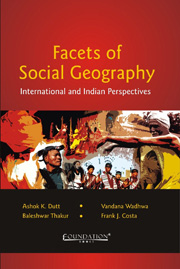Book contents
- Frontmatter
- Contents
- Foreword
- Preface
- Acknowledgements
- List of Contributors
- I Introductory Framework: Allen G. Noble's Contribution to Social Geography
- II Conceptual and Theoretical Basis of Social Geography
- III Social Geography from a Global Perspective
- 9 Regional Patterns of Spanish-Language Newspaper Publication in the United States, 1848–1992
- 10 Enterprise Zones in a Global Perspective: Socioeconomic Consequences
- 11 Multi-faceted Regional Inequality in China
- 12 Social Geography of the Minorities in Israel
- 13 Urban Sprawl and Socioeconomic Change in the Kathmandu Valley, Nepal
- 14 Ave Maria: A Planned Town in Collier County, Florida
- IV Social Geography in the Indian Context
- V Indian Social Geography: City and State Context
- Index
12 - Social Geography of the Minorities in Israel
from III - Social Geography from a Global Perspective
Published online by Cambridge University Press: 05 June 2012
- Frontmatter
- Contents
- Foreword
- Preface
- Acknowledgements
- List of Contributors
- I Introductory Framework: Allen G. Noble's Contribution to Social Geography
- II Conceptual and Theoretical Basis of Social Geography
- III Social Geography from a Global Perspective
- 9 Regional Patterns of Spanish-Language Newspaper Publication in the United States, 1848–1992
- 10 Enterprise Zones in a Global Perspective: Socioeconomic Consequences
- 11 Multi-faceted Regional Inequality in China
- 12 Social Geography of the Minorities in Israel
- 13 Urban Sprawl and Socioeconomic Change in the Kathmandu Valley, Nepal
- 14 Ave Maria: A Planned Town in Collier County, Florida
- IV Social Geography in the Indian Context
- V Indian Social Geography: City and State Context
- Index
Summary
The State of Israel made great efforts to absorb hundreds of thousands of Jewish immigrants during the 1950s and 1990s. It has prepared for them a physical, economic and social infrastructure in the country and has integrated them into a community that is prospering by the day. Unfortunately, Israel has not done enough for the Arab minorities. The Arabs who live in the sovereign territory of Israel form a large share of the country's population, own much land in regions where they reside and are very much involved in Israel's politics. The Arab minorities who live in ‘a State within a State’, deserve a more serious treatment from the governmental bodies of Israel because of their demographic weight in the total population and their occupancy of large areas along the Israeli border with Judea and Samaria. The scope of the chapter is up to the September 2000 conflict, as it conspicuously marks some of the ramifications of these social geographic elements mentioned above.
Demographic Background
At the end of 1991, the minorities in Israel totalled 1,200,000 – about 17 per cent of the population in Israel. Their share in the total population is similar to that of the Jewish populations that reside in the new development towns. Most of the minorities are concentrated in the Northern District, including Upper and Lower Galilee. In 1991, this district comprised about 48 per cent minorities, a fact which demonstrates that both, minorities and the Jewish peoples in Galilee were demographically almost in complete balance.
- Type
- Chapter
- Information
- Facets of Social GeographyInternational and Indian Perspectives, pp. 228 - 235Publisher: Foundation BooksPrint publication year: 2012



